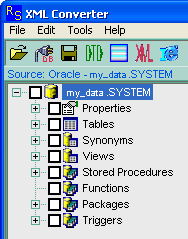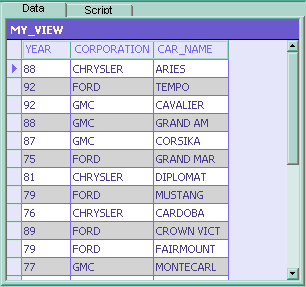 |
|
|

|
 |
You can open and browse some Oracle database objects. The types of database objects that XML Converter supports for an Oracle database are:
Properties
Tables
Synonyms
Views
Stored Procedures
Functions
Packages
Triggers
|
|
Also you may overwrite the previous view. Go back to "Script" section of middle pane and rewrite your query, change something in query script. For example, you may change your query SQL script:
SELECT * FROM MY_TABLE ORDER BY YEAR
Click "Save" button and go back to "Data". Your view will be replaced and corresponding query result will be recreated.
To start data transformation just click "XML" button on main XML Converter toolbar.
After reviewing or editing your destination XML output in a special window (right pane) you can save the XML file by using "Save" dialog box.
|
 |

|
|
  Resume Resume
|
 |
|
It is very likely that your first question would be: why should I use that XML Converter if I already can create an XML output from Oracle SQL queries by using some Oracle utilities (XSU, XSQL) in my java code? Indeed, every professional programmer has his own ways and methods to convert Oracle data to XML format. Youre quite right! Dont spend your money until you finally decide that you really want to:
  Eventually understand, what the heck XML Converter does with your data; Eventually understand, what the heck XML Converter does with your data;
  What XML Converter takes as its source and what it produces; What XML Converter takes as its source and what it produces;
  See on your screen something more human friendly than just freaking mysterious process done...; See on your screen something more human friendly than just freaking mysterious process done...;
  Set very powerful transformation control software, flexible and elastic, yet with a really simple and friendly user interface Set very powerful transformation control software, flexible and elastic, yet with a really simple and friendly user interface
|
|
  By using XML Converter you can apply common SQL statements to output your data into XML format. Levering Microsoft ADO .NET technology, ODBC, any supporting OLEDB database can be connected to, any valid SQL statement can be executed, and the results will be stored in a simple XML document. Queries can be nested and parameterized, so foreign table relationships are conveniently supported. That makes XML Converter an easy-to-use SQL-XML conversion tool. By using XML Converter you can apply common SQL statements to output your data into XML format. Levering Microsoft ADO .NET technology, ODBC, any supporting OLEDB database can be connected to, any valid SQL statement can be executed, and the results will be stored in a simple XML document. Queries can be nested and parameterized, so foreign table relationships are conveniently supported. That makes XML Converter an easy-to-use SQL-XML conversion tool.
|
|
Main Features of XML Converter related to Oracle database are:
  Supports Generation of XML documents from Oracle tables and/or views. Supports Generation of XML documents from Oracle tables and/or views.
  Supports in XML Converter GUI inserts, updates, and deletes of database records. Update data directly to Oracle database. These updates are corresponding to a given XML document. Supports in XML Converter GUI inserts, updates, and deletes of database records. Update data directly to Oracle database. These updates are corresponding to a given XML document.
  Supports general Oracle data types. Supports general Oracle data types.
  Create and update Oracle views. By using XML Converter you can create a view in your Oracle database, browse query result, update the view and store it. Create and update Oracle views. By using XML Converter you can create a view in your Oracle database, browse query result, update the view and store it.
  Supports dynamic generation of Document Type Definition (DTD) or XML Schema Definition (XSD) while retrieving an XML document from the database. Supports dynamic generation of Document Type Definition (DTD) or XML Schema Definition (XSD) while retrieving an XML document from the database.
  Supports simple transformation of the retrieved XML document using XML Stylesheets (XSL). Supports simple transformation of the retrieved XML document using XML Stylesheets (XSL).
|
 Copyright © 2001-2024 Rustemsoft LLC All Rights Reserved. Copyright © 2001-2024 Rustemsoft LLC All Rights Reserved.
|
|
|







